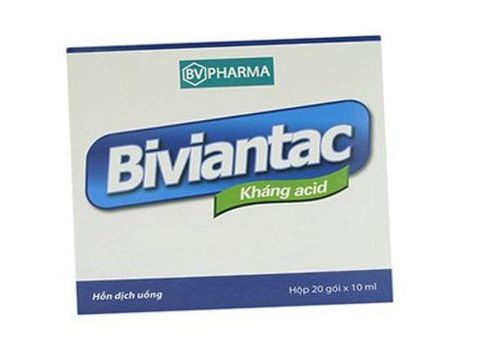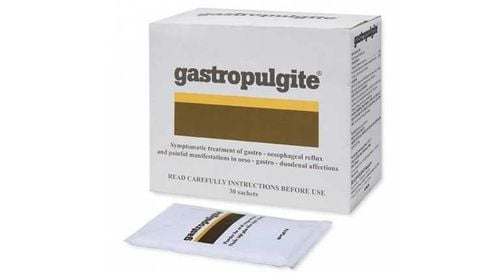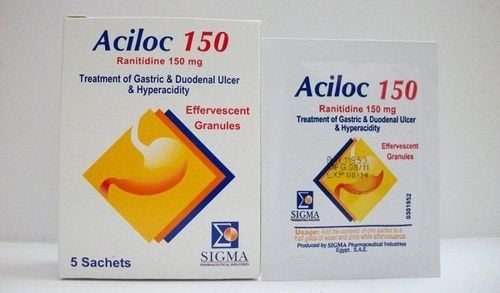This is an automatically translated article.
What is Lantota, is it a medicine for gastrointestinal diseases? With the main ingredient is Lansoprazole, Lantota drug is used in the treatment of ulcers of the esophagus, stomach and duodenum and other acidosis syndromes.
1. What is Lantota?
Lantota belongs to the group of gastrointestinal drugs, with the main ingredient being Lansoprazole (in the form of lansoprazole pellet 8.5%) with a content of 30mg. Lansoprazole is a proton pump inhibitor that inhibits gastric acid secretion at baseline or when stimulated by other agents. Compared with H2-receptor antagonists, Lansoprazole has a better ability to inhibit gastric acid secretion.
Lantota is made in the form of hard capsules and is indicated for use in the following cases:
Treatment of erosive esophagitis (acute or sustained) in patients with gastroesophageal reflux disease (duration of the esophagus) medication can be up to 8 weeks). Treatment of acute gastritis - duodenal ulcer. Treatment of hypersecretory diseases such as Zollinger - Ellison syndrome, systemic mastocytosis, polyendocrine tumors. In addition, Lantota can be combined with Amoxicillin and Clarithromycin to treat gastritis caused by H.pylori bacteria.
2. How to use and dose Lantota
Lantota is taken orally. Take the medicine with water and should be taken in the morning before eating. Do not chew or break the medicine because the composition of Lantota is not stable in the acidic environment of the stomach.
Dosage of Lantota in the treatment of specific erosive esophagitis is as follows:
Short-term use for all cases of esophagitis: 30mg/time/day, taking the drug for 4-8 weeks and If not cured, you can take the medicine for another 8 weeks. Long-term maintenance use to reduce recurrence of erosive esophagitis after treatment has been cured: 15mg/time/day. Do not take the drug for longer than 1 year because safety and effectiveness have not been established. Dosage of Lantota in the treatment of stomach ulcers: 15 - 30mg / time / day, take the drug for 4 - 8 weeks in the morning, before breakfast.
Dosage of Lantota in the treatment of duodenal ulcer: 15mg/time/day, orally for 4 weeks or until the disease is cured. This dose can be used for maintenance therapy after cure, but should not be used for longer than 1 year because safety and effectiveness have not been established.
Dosage of Lantota in combination with Amoxicillin and Clarithromycin in the treatment of active duodenal ulcers caused by H. pylori infection is as follows:
Use a combination of 3 drugs: Lantota 30mg + Amoxicillin 1g + Clarithromycin 500mg, take 2 each time times/day before each meal for a period of 10-14 days. Use a combination of 2 drugs: Lantota 30mg + Amoxicillin 1g each time, 3 times a day before each meal for a period of 14 days. Dosage of Lantota in the treatment of Zollinger - Ellison syndrome, polyendocrine tumors, systemic mastocytosis:
The usual initial dose is 60mg/time/day, then, depending on tolerability and amount needed to inhibit gastric acid secretion will adjust the dose and duration of use until clinical results are achieved. Maintenance dose of Lantota: 15 - 180mg/day to maintain baseline gastric acid secretion below 10mEp/hour (for patients who have undergone gastric bypass surgery, 5mEp/hour). With doses above 120mg/day, the drug should be taken twice a day. In patients with severe hepatic impairment, the dose of Lantota should be adjusted; the recommended dose should not exceed 30 mg/day.
Lantota overdose can cause hypothermia, convulsions, sedation, respiratory depression. In this case, the patient should receive supportive treatment but note that hemodialysis will not be removed because the drug will not be removed.
3. Side effects of the drug Lantota
Lantota medicine can cause some unwanted side effects with the frequency of occurrence as follows:
Common: Dizziness, headache, abdominal pain, diarrhea, nausea, vomiting, indigestion, constipation, rash on the skin. Uncommon: Fatigue, increased liver enzymes, gastrin, hemoglobin, hematocrit, uric acid, proteinuria. If you see any strange symptoms after taking Lantota, you should immediately report it to your treating doctor or go to a medical facility to check your health status.
4. Some notes when using Lantota
Do not use Lantota in people with hypersensitivity to the ingredients of the drug. Women who are pregnant, especially the first 3 months and women who are breastfeeding should not take Lantota because the drug can be passed through the placenta and excreted in breast milk, seriously affecting the fetus and newborn. . Do not take Lantota together with drugs that metabolize cytochrome enzymes. Lantota also reduces the effect of Ketoconazole, Itraconazole and other drugs whose absorption requires an acidic environment. Concomitant administration of sucralfate slows and decreases the absorption of Lantota. The use of Lantota is to inhibit gastric acid secretion in the treatment of esophageal ulcers, gastritis - duodenitis, acidosis syndrome. In addition, the drug can also be used in combination with other drugs to treat gastritis caused by H.Pylori bacteria. To ensure safety for your health and maximize the effectiveness of your treatment, you need to take Lantota exactly as directed by your doctor.
Please dial HOTLINE for more information or register for an appointment HERE. Download MyVinmec app to make appointments faster and to manage your bookings easily.













